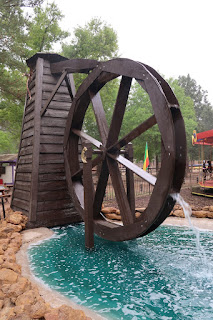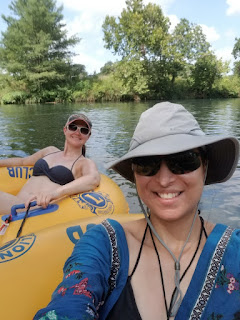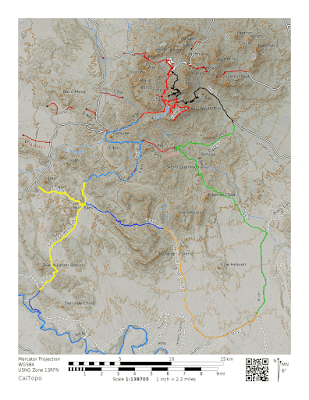The Maiden of the Rock: A Deep Dive into Xunantunich Mayan Ruins in Belize
- Get link
- X
- Other Apps
The Maiden of the Rock: A Deep Dive into Xunantunich Mayan Ruins in Belize
The Journey Begins with a Hand-Cranked Ferry
Getting to Xunantunich is a part of the adventure in itself, and it’s a detail that adds to the site's remote and timeless feel. The day of our visit was incredibly sunny, and the drive to the site was straightforward. However, the parking situation was a little confusing, and we had to circle a few times to figure it out. We eventually realized that most people take a bus or taxi, and not many tourists drive themselves. Once we found a spot, we walked over to the Mopan River.
To access the ruins, you must first cross the Mopan River on a hand-cranked ferry. It’s a short trip, but it's such a unique and fun experience that immediately transports you away from the modern world, adding a layer of anticipation to your visit. For more information on planning your trip, visit the Official Belize Tourism website.
Exploring with a Local Guide
Once across the ferry, we secured the services of a local tour guide. She was incredibly knowledgeable and passionate about the history of the ruins. She pointed out intricate details and shared fascinating stories that brought the site to life. Her guidance was invaluable as we explored the sprawling grounds, but our time with her was cut a little short at the end as she had to rush to pick up her child from school for lunch.The site itself is a fascinating juxtaposition of ancient and modern. Xunantunich is located just a few miles from San Ignacio, and from higher points on the ruin, we could still see parts of the city and hear loud noises from time to time. Because of this proximity, we didn't encounter much wildlife beyond the birds in the surrounding jungle. This was a stark contrast to what you might expect from a jungle ruin, and it was a surprising part of our adventure. If you're following our journey, you can see how we kicked off our adventure in our Day 1 Adventure at Cryscal Cave and in our Day 2 cave tubing posts.
Conquering El Castillo: A Breathtaking Reward
The centerpiece of Xunantunich is undoubtedly El Castillo, a majestic pyramid that towers over the surrounding landscape at 130 feet high. Our first thought upon seeing it was how impressed we were with its size. It piqued our curiosity about how it must have looked in all its splendor. The climb to the top is an experience in itself, with ancient stone steps leading you higher and higher. The sun was intense on the way up, and the stairs became very narrow towards the top, so we had to be careful with each step.
But the effort is more than rewarded with a view that is simply breathtaking. From the summit, you are treated to a 360-degree panorama of the dense jungle canopy stretching out for miles. On a clear day, you can see all the way to the mountains of Guatemala in the distance. It’s a truly humbling experience to stand where ancient rulers once stood, overseeing their domain. For a more in-depth historical context on this ancient civilization, you can check out this on the Maya.
The Art of the Ancients: Unraveling the Frieze
One of the most captivating features of El Castillo is its intricate frieze. This elaborate stucco decoration, which once wrapped around the entire temple, is a stunning example of Mayan artistry and symbolism. The frieze is in great shape, even if all the color is gone, and it's wonderful to learn about the original look of the frieze. Although you can't get too close to it, it is still large enough to get a great glimpse of the details.
The frieze depicts various deities and celestial bodies, including the Sun, Moon, and Venus. These elements were crucial to the Maya, who were advanced astronomers and believed that the movements of the heavens were tied to the fate of their civilization. Studying these carvings is a humbling experience, offering a direct connection to the spiritual and intellectual life of the ancient Maya. Archaeologists have identified figures representing creation gods and ancestral rulers, revealing a complex narrative of power and lineage.
Practical Tips for Your Visit
To ensure your visit to Xunantunich is as comfortable and enjoyable as possible, here are some tips based on our own experience:
Best Time to Visit: We recommend arriving early in the morning. The temperatures are cooler, and you can beat the tour groups that arrive later in the day.
What to Bring: The jungle can be hot and humid, so be sure to bring plenty of water, sunscreen, and insect repellent. The paths are mostly made of grass, dirt, and stone, so a good pair of walking shoes is essential.
Embrace the Journey: The ferry ride, the uphill trek to the site, and the climb up the pyramid are all part of the fun. Take your time, and don't rush the experience.
Learn from a Guide: While you can explore on your own, hiring a local guide is highly recommended. For the most up-to-date information on the site, including hours and fees, you can check here.
Xunantunich is more than just a destination; it's a window into an ancient civilization, offering a truly immersive historical adventure. To see every step of our journey from the ferry crossing to the breathtaking view from the top, be sure to watch the full video above!
- Get link
- X
- Other Apps








Comments
Post a Comment